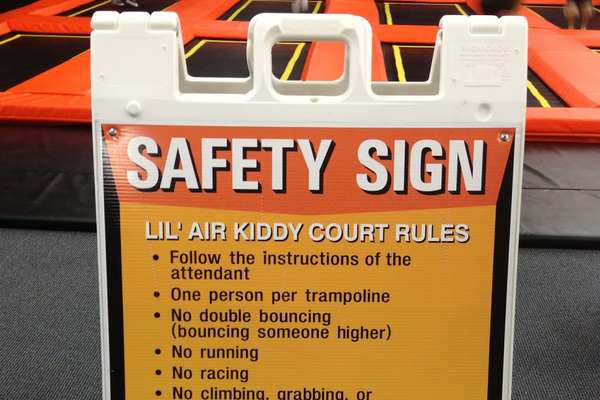Trampoline Rules And Regulations

There are many different types of trampolines, from the small backyard trampoline to the large professional ones used in competitions. No matter what size or type of trampoline you have, there are certain rules and regulations that should be followed in order to ensure a safe and fun experience for all.
If you’re planning on buying a trampoline or already have one, it’s important to know the rules and regulations for safe use. Here are some things to keep in mind:
• Always have at least one person supervising when the trampoline is in use.
• Only allow one person on the trampoline at a time.
• Keep away from obstacles like trees, fences, and buildings when jumping.
• Don’t attempt any stunts or flips unless you’re a trained professional.
• Inspect the trampoline regularly for any damage or wear and tear.
What are the Basic Rules of Trampoline?
If you’re looking to get into trampoline, there are a few basic rules you should know. First and foremost, always make sure there’s a spotter nearby when you’re jumping. Trampolines can be dangerous if you don’t take the proper precautions.
Always warm up before you start jumping. A few simple stretches will help get your muscles ready for the workout they’re about to endure.
Start slow at first.
Get a feel for the trampoline and how it reacts to your movements. Once you’re comfortable, you can start trying some more advanced tricks. But always be mindful of your surroundings and never try anything beyond your skill level.
Finally, have fun! Jumping on a trampoline is a great way to let off some steam and have a good time. Just be safe and enjoy yourself.
Do You Have to Have a Fence around a Trampoline?
No, you do not have to have a fence around a trampoline. However, doing so can help keep children and pets safe while the trampoline is in use. A fence can also provide some privacy for those using the trampoline.
Can You Have a Trampoline in Your Backyard?
Yes, you can have a trampoline in your backyard. There are a few things to keep in mind, though. First, make sure you choose a spot that’s level and free of debris.
You’ll also want to measure the space so you know what size trampoline to buy. Finally, consider installing a net around the perimeter of the trampoline to help keep everyone safe while they’re bouncing around.
How Close to a House Can You Put a Trampoline?
You might be surprised to learn that there are actually no definitive answer to this question. It largely depends on your specific municipality and homeowners association (if you have one). Some places have ordinances that regulate how close to a property line you can place a trampoline, so it’s always best to check with your local authorities first.
That being said, a good rule of thumb is to place the trampoline at least 10 feet away from any structures, including your house. This will help ensure that the trampoline is stable and secure, and reduce the risk of damage to your property if the trampoline were to fall over.

Credit: www.pinterest.com
Trampolining Safety Rules
When it comes to trampolining, safety should always be a top priority. There are a few key safety rules that everyone should follow when using a trampoline, including:
1) Only one person at a time should be on the trampoline.
This will help to avoid collisions and injuries.
2) Always use the proper safety equipment, such as a helmet and pads for your knees and elbows.
3) Make sure the trampoline is properly set up before using it.
This includes making sure all of the legs are securely in place and that there are no gaps between the mat and the frame.
4) Do not attempt any flips or other stunts on the trampoline unless you are experienced and know how to safely land them. These maneuvers can easily lead to injury if not done correctly.
5) If you fall off of the trampoline, make sure to get off of it quickly so that someone else can use it. Do not try to climb back on without first checking with an adult or supervisor.
Trampoline Injuries 2020
As the weather gets warmer, many people are dusting off their trampolines and getting ready for some outdoor fun. Unfortunately, trampoline injuries are also on the rise. In fact, the Consumer Product Safety Commission (CPSC) reports that there were nearly 113,000 trampoline-related injuries treated in hospital emergency rooms in 2020.
That’s an increase of nearly 9% from 2019!
Most of these injuries (70%) are to children under the age of 16. And while boys sustain more trampoline injuries overall, girls are more likely to be seriously injured.
In fact, CPSC data shows that girls account for 55% of all trampoline-related fractures and 66% of all dislocations.
The most common type of injury is a sprain or strain (44%), followed by fractures (27%). The most common bone fractured in a trampoline injury is the forearm, followed by the ankle and leg.
Head and neck injuries are also relatively common, accounting for about 16% of all ER visits.
While most people think of backyard trampolines when they think of trampoline injuries, indoor commercial facilities like those found at gyms or amusement parks account for a significant number of accidents as well. In fact, one study found that nearly 40% of pediatric ER visits for trampoline injuries were associated with commercial locations.
There are several things you can do to help prevent trampoline injuries:
• Only allow one person on the trampoline at a time; no double bouncing!
• Make sure everyone using the trampoline is wearing proper safety gear including shoes and padding for any exposed body parts like knees or elbows.
Wrist guards are also recommended if doing flips or other tricks.
Trampoline Safety Net
A trampoline safety net is an important safety feature for any trampoline. It helps to keep users safe by preventing them from falling off the trampoline and injuring themselves. A safety net should be made of durable, heavy-duty material that can withstand repeated use.
It should also be attached to the trampoline frame securely to prevent it from becoming detached during use. When choosing a safety net for your trampoline, make sure to select one that is the appropriate size and shape for your trampoline.
Common Trampoline Injuries
Most people associate trampolines with fun and games. However, this popular backyard activity can also lead to serious injuries, especially for children. According to the U.S. Consumer Product Safety Commission (CPSC), there are an estimated 100,000 trampoline-related injuries each year in the United States.
The most common types of injuries are broken bones, sprains and strains, and bruises or contusions. The most serious injuries are concussions and spinal cord injuries, which can cause paralysis.
To reduce the risk of injury, the CPSC recommends that only one person at a time use a trampoline, and that jumpers avoid somersaults and flips.
Additionally, it is important to have proper padding around the frame and springs of the trampoline, as well as a net enclosing the jumping area.
Pros And Cons of Trampolines
The Pros and Cons of Trampolines
Most people think of trampolines as a fun backyard activity for kids. And while they can be great for that, there are also some potential risks associated with them.
Here, we’ll take a look at both the pros and cons of trampolines so you can make an informed decision about whether or not one is right for your family.
PROS:
1. They’re great exercise.
Jumping on a trampoline is actually a really great workout! You’ll get your heart rate up and tone your muscles all at the same time.
2. They’re perfect for rainy days.
If the weather isn’t cooperating but you still want to let the kids burn off some energy, a trampoline is the perfect solution. Just set it up in the garage or basement and let them go to town!
3. They help improve coordination and balance.
Because jumping on a trampoline requires coordination and balance, it can actually help improve those skills over time – especially in young children who are still developing them.
CONS:
1 .
There’s always the risk of injury . Anytime you jump on a trampoline , there ‘ s going to be some risk involved . You could fall off , hit your head , or land wrong and twist an ankle or knee . Be sure to supervise children closely when they ‘ re using a trampoline , and consider investing in safety netting to reduce the risk even further .
2 There is such thing as too much exercise While getting regular exercise is important , too much of anything can be bad for you .
If you find yourself spending hours every day bouncing on the trampoline , it might be time to cut back lest you end up over-exercising and injuring yourself .
Aap Trampoline
Aap Trampoline is a family-owned trampoline park in the heart of downtown Los Angeles. We offer a variety of classes for all ages and abilities, as well as open jump times and special events. Our state-of-the-art facility features high quality trampolines, foam pits, and a host of other amenities to make your experience safe and enjoyable.
Conclusion
There are a few key trampoline rules and regulations that you should be aware of before allowing your children to play on one. First, make sure the trampoline is placed in an open area away from any trees, bushes, or other objects that could potentially cause harm if someone were to fall off. Second, never allow more than one person at a time on the trampoline as this increases the risk of injury.
Finally, always supervise children while they are playing on the trampoline and enforce the rules to help keep everyone safe.
